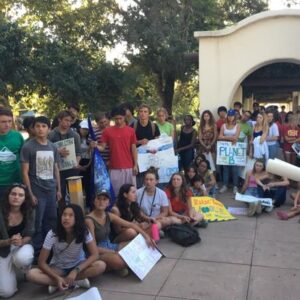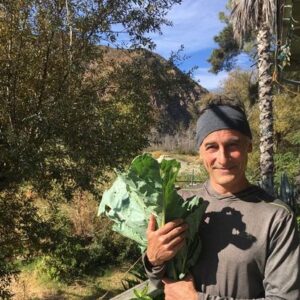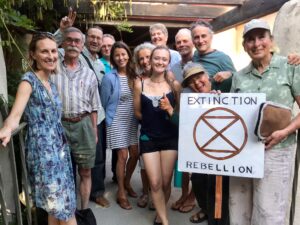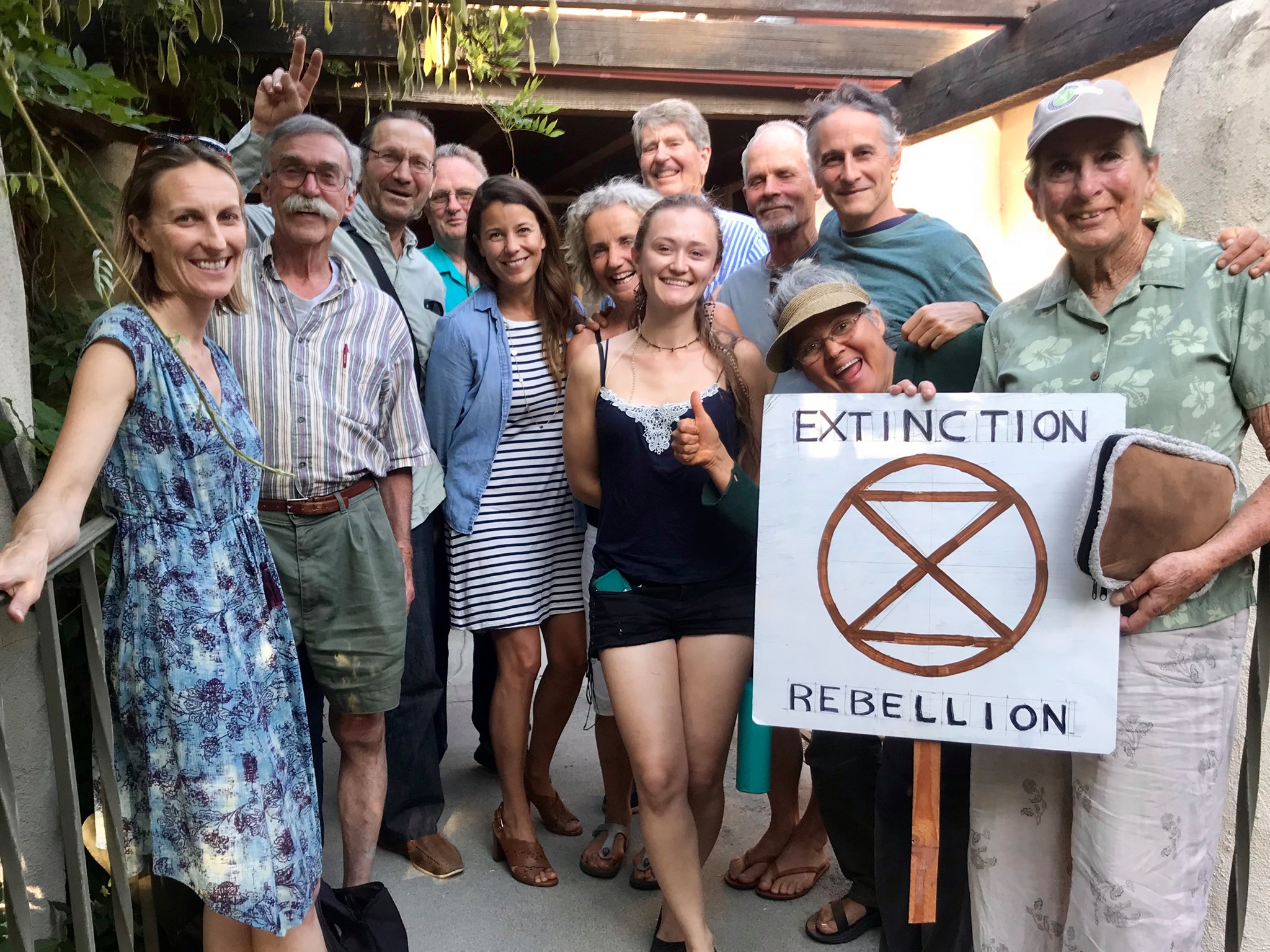FEATURE | By Kit Stolz
Healing our Climate, Ourselves

Children’s Climate Strike in Ojai
The news from Earth’s atmosphere is not good; in fact, the warming has become so alarming that the language used by journalists and scientists to report on the changes in the air has itself begun to change, in ways that may well become as irreversible as the steadily rising annual temperatures in Ojai and around the planet.
What was mostly called “global warming” in the 1970s and 1980s became known as “climate change” in the 1980s and ‘90s, which many scientists preferred because it reflected the uneven distribution of warming and impacts. (Some political figures also prefered the phrase “climate change,” because it sounds less threatening.)
Now some scientists use the phrase “global heating,” because annual temperatures around the world continue to jump, and because many already-warm places, including Ojai, face intensifying “hot droughts” and heat waves, according to projections.
This year a petition signed by over 12,000 climate scientists around the world called for the media to use the phrase “climate emergency,” a framing adopted by Scientific American this year.
For Ojai author Jack Adam Weber, the rhetorical changes in the scientific language used to describe the crisis are probably overdue but aren’t likely to touch the deeper emotions, which is where he argues we must go to find the urgency necessary to meet the challenge.

Author Jack Weber at his Matilija Canyon home
In his book “Climate Cure: How to Heal Yourself to Heal the Planet,” issued in 2020 from Llewellyn Publishing of Minnesota, Weber argues that we will not meet the crisis until we feel the tragedy deeply, which means moving past the finger-pointing and the blaming and bringing the pain and loss of a planet transformed and damaged by climate change into our hearts.
Basically we’re all complicit, but some of us are more so,” he said. “I didn’t want to harp on it. The blame doesn’t do much in terms of healing. I didn’t get into rants either — I feel the rants have all been written. The information is out there. We all know what we need to do, or it’s easy to find out. The issue is not so much what we need to do outwardly, the issue is why don’t we care enough?”
Last decade the climate emergency — most destructively seen in the form of the Thomas Fire — hit Ojai hard. Weber himself was thrown up against an overwhelming wave of environmental devastation, from not just the Thomas Fire, but also at a farm in Hawaii, from an outflow of lava.
After evacuating from Meiners Oaks in December of 2017, where he had been visiting family, Weber flew in 2018 back to his five-acre organic farm and handcrafted home on the Big Island of Hawaii, only to see it inundated by molten lava from the Kilauea volcano five months later. Overnight, Weber lost the farm and home that he had put 18 years into creating.
The twin disasters left Weber bereft, unsure which way to turn. To get back on his feet he reached out, first to his neighbors.
“I formed two grief circles,” he said, in an interview conducted in Ojai’s lush, little-known neighborhood sanctuary, Daly Park. “The first one I led in Hawaii after I lost everything. I was the only one in my small community who was wiped out completely by the lava, but I wasn’t the only one forced to evacuate. I put it out to friends, and we formed a circle and it was amazing. So helpful. We cried together.”
In “Climate Cure” Weber puts this in the category of “Holding Space,” and credits his neighbors on the Big Island with showing him how to help traumatized others heal.
“On my home turf in Hawaii, I and a dozen other lava flow refugees were welcomed in by a loving couple who gave us a place to stay on their farm,” he writes. “They asked for nothing in return, and we all found unique ways to contribute as best we could. Their big hearts and gestures of loving-kindness not only helped me immensely during a devastating time of loss, but impressed me and changed me in ways I’m still discovering.”
A couple of central insights came out of Weber’s grief work. First, he argues, drawing on his experience as a Chinese medicine practitioner, that “sitting with” loss and pain, comparable to fallowing in agriculture, leads to an inner enrichment and ultimately to a rebirth of energy and spirit. A desire to start again.
“We don’t grieve; grief does us,” is how he phrases this process. Although he has worked with a therapist in the past, and has as well intensively studied the scientific literature of climate, he believes that in the end restorative action comes out of faith in “the community as guru.”
“Embracing our sadness softens our hearts and engenders compassion,” he writes, “allowing us to connect with others. Grief and love are two sides of the same coin.”
Along these lines, back in Ojai he launched a weekly “Climate Discussion and Support Group” to share about the climate emergency, which turned out to be a good move for not just himself, but for his community, and — arguably — for Ojai as well. (During the pandemic this group evolved into a general support group to help members struggling with issues raised by the coronavirus.)
“Meeting with the group put us in touch with that place in the heart that is hard to reach in the stresses of our daily lives,” he said. “We need the containment and the support of other people. Grief flows most easily in the compassionate company of others.”
One attendee, artist Christine Brennan, credits Weber’s climate circle with helping her face up to the climate emergency here.
‘There’s a heartbreak about knowing what is going on with our climate,” she said. “Witnessing what is going on with our trees has been painful for me. I’m a board member of Ojai Trees and we see it all the time — so many trees are coming down, so many trees are not making it. The sun has become stronger and we can’t plant a tree anymore without assigning someone to take care of it. There’s a huge increase in the bugs that attack plants that are not thriving. Ever since the Thomas Fire the amount of trees that need to be cut for fire damage or electric lines has been never-ending, so you have that constant background noise of tree-trimming chainsaws.”
Weber points out that most advocates and climate scientists believe that to be effective, climate action inevitably must come from the top down and from the bottom up, meaning that one of the most important climate actions a person can take is to lobby one’s own government. Along those lines, with residents Kathryn Barron and Jeff Otterbein, among others, he formed a local chapter of the UK-based Extinction Rebellion, and in the aftermath of the Thomas Fire called on the Ojai City Council to declare a “climate emergency.”
“Ojai has a reputation as a green community,” he said. “We have a chance to be exemplary, in the US and around the world. Let’s really do this thing, let’s pump up the city council members to let them know how to inspire the community to do something great.”

A group of Ojai activists celebrate the passage of a climate emergency resolution by the Ojai City Council
Encouraged by presentations from Weber and many other activists, in July of 2019 the Ojai City Council declared a “climate emergency,” and empowered a committee to bring forward recommendations for action, including asking for “high-priority strategies to achieve emissions reductions at emergency speed.”
A year later the Climate Emergency Mobilization Committee brought forward a nine-page set of recommendations, including the electrification of buildings and the banning of new gas appliances hookups, as well as support for electric vehicles and the “envisioning of an Ojai free of internal combustion engines by 2030.”
Betsy Stix, elected Mayor of Ojai last November, thanks Weber, fellow activists including Ojai’s prominent clean power advocate Michelle Ellison, and former Mayor Johnny Johnston for moving local government to act on the climate emergency in Ojai. She thinks back to a heartfelt letter that Weber wrote the City Council in 2020 calling on Ojai as a model city to lead in the climate emergency.
Weber wrote that “the value of Ojai becoming a climate leader is not so much for the amount of carbon we will prevent from being released to an already carbon-saturated atmosphere, but for the example we set for larger municipalities to follow suit.”
Stix said found the letter inspirational. She called Weber back, and they had a good conversation on how to motivate the necessary changes. She adds that Ojai has started to take action to meet the climate emergency.
“Ojai led the county by being the first city to embrace 100 percent clean energy,” she said. “That was a great start. We have a long way to go, however, to attain exemplar status.”
Last October the Ojai City Council followed up on the mobilization committee’s recommendations by banning gas appliance hookups in new buildings, the first such community to do so in Ventura County. The measure passed by a 4-1 vote in the City Council, but Stix still feels that much more could be done if — as Weber says — more Ojaians and City Council members took the climate emergency to heart.
“Everyone on the Council is concerned about climate,” she said. “How could we not be? Many people get climate intellectually. The question is, does one truly feel it in the body? What I’ve observed is that those who get climate intellectually, emotionally, and instinctually take specific, effective action without delay. Those who only get it intellectually have real trouble making the tough choices recommended by our Climate Committee that are necessary to leave our children a habitable planet. The lack of climate urgency by some on our Council indicates that they just haven’t gotten there yet.”
Stix — and many climate activists — wants to see Ojai do much more, including the replacement of City equipment, infrastructure, and vehicles that reach the end of their useful life with zero emission alternatives. She wants to encourage a transition away from fossil fuels such as natural gas in our infrastructure, and hopes residents too can find ways to use zero or low emission transportation. She wants to see delivery fleets in the valley employed by the U.S. Post Office, Amazon, FedEx, and others go to zero emissions within a few years, and wants to see Ojai increase fire safety by replacing “incendiary, ember-producing non-native trees and shrubs with natives that are more fire resistant.”
Weber supports these recommendations, but isn’t inclined to wait. He argues that our recent catastrophic national experience with COVID will turn out in its enormity to be a trial run for what is coming from the climate emergency. This could be a silver lining, at least in theory.
“I call it Lockdown with Benefits,” he said, referencing an essay he published on Medium by the same name in 2020. “Living in smaller local communities, and riding bikes and walking is a way to reclaim this life with minimal impact,” he writes in the essay, adding that people should fight for their right to work at home, among many other changes.
“It’s uncanny that coronavirus has provided a model for surviving climate crisis,” he argues.
Although he is not confident that we will take this opportunity to reduce greenhouse gas emissions — which fell a record 12 percent last year in the U.S — nonetheless he vows that “I will continue lockdown with benefits — how to open up locally for myself, how to live respectfully, with time to grieve and to care for those around me. And I will invite my friends to join me.”
Weber continues to facilitate the Climate Change Discussion and Support Group every two weeks, as well as a seasonal Grief and Gratitude Circle in Ojai. Anyone interested in participating can contact Weber at jackadamweber@gmail.com for details.


Leave A Comment